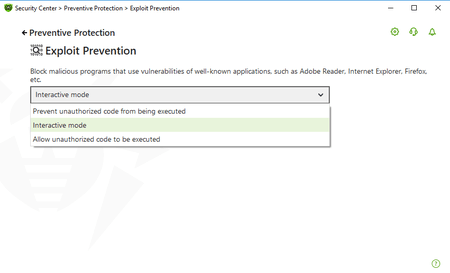Exploit Prevention
Almost every computer has a "back door" that attackers can use to penetrate your digital home.
The Exploit Prevention component will keep data safe from malware that exploits vulnerabilities in popular applications to try to penetrate a system. When it detects that an attempt is being made to exploit a vulnerability, Dr.Web will forcibly terminate the process of the program being attacked.
An exploit is a malicious program, a sequence of commands, or special malicious code that exploits vulnerabilities to deliver Trojans into a system or hack software. There also exist exploit kits, which are designed to leverage a number of vulnerabilities.
An exploit lets attackers infiltrate systems covertly. Even if your OS is configured to warn you at program start-up that a program may be malicious, the malicious code in that program can be executed without your knowledge through the exploitation of vulnerabilities.
Dr.Web protects against exploits by intercepting programs that are being injected via a vulnerability.
Impregnable systems do not exist!
Developers try to release patches quickly for known vulnerabilities. For example, Microsoft releases security updates quite regularly. However, users often install some of them way too late (or don't install them at all). This encourages intruders to search for new vulnerabilities and exploit those that have been discovered but not yet closed on at-risk computers.
Find out more
Read the Anti-virus Times columns "Con artists" and "Caught" to learn how cybercriminals use malicious programs and social-engineering techniques to try to worm their way into people’s confidence and make them willingly engage in whatever actions they need them to undertake.
 Dr.Web Security Space
Dr.Web Security Space Dr.Web Katana
Dr.Web Katana Dr.Web Premium
Dr.Web Premium Dr.Web Security Space
Dr.Web Security Space Dr.Web Security Space
Dr.Web Security Space Dr.Web Katana
Dr.Web Katana Dr.Web Security Space
Dr.Web Security Space
